Related Research Articles

The stability of a plasma is an important consideration in the study of plasma physics. When a system containing a plasma is at equilibrium, it is possible for certain parts of the plasma to be disturbed by small perturbative forces acting on it. The stability of the system determines if the perturbations will grow, oscillate, or be damped out.

Magnetic confinement fusion (MCF) is an approach to generate thermonuclear fusion power that uses magnetic fields to confine fusion fuel in the form of a plasma. Magnetic confinement is one of two major branches of controlled fusion research, along with inertial confinement fusion.
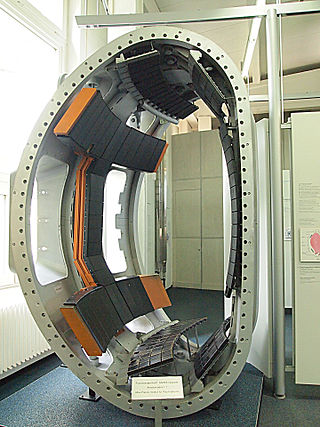
ASDEX Upgrade is a divertor tokamak at the Max-Planck-Institut für Plasmaphysik, Garching that went into operation in 1991. At present, it is Germany's second largest fusion experiment after stellarator Wendelstein 7-X.
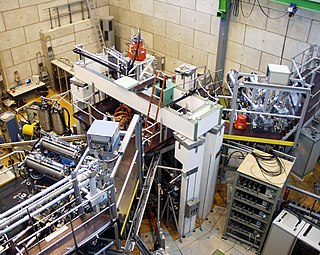
The tokamak à configuration variable is an experimental tokamak located at the École Polytechnique Fédérale de Lausanne (EPFL) Swiss Plasma Center (SPC) in Lausanne, Switzerland. As the largest experimental facility of the Swiss Plasma Center, the TCV tokamak explores the physics of magnetic confinement fusion. It distinguishes itself from other tokamaks with its specialized plasma shaping capability, which can produce diverse plasma shapes without requiring hardware modifications.
An edge-localized mode (ELM) is a plasma instability occurring in the edge region of a tokamak plasma due to periodic relaxations of the edge transport barrier in high-confinement mode. Each ELM burst is associated with expulsion of particles and energy from the confined plasma into the scrape-off layer. This phenomenon was first observed in the ASDEX tokamak in 1981. Diamagnetic effects in the model equations expand the size of the parameter space in which solutions of repeated sawteeth can be recovered compared to a resistive MHD model. An ELM can expel up to 20 percent of the reactor's energy.
John Bryan Taylor is a British physicist known for his contributions to plasma physics and their application in the field of fusion energy. Notable among these is the development of the "Taylor state", describing a minimum-energy configuration that conserves magnetic helicity. Another development was his work on the ballooning transformation, which describes the motion of plasma in toroidal (donut) configurations, which are used in the fusion field. Taylor has also made contributions to the theory of the Earth's Dynamo, including the Taylor constraint.
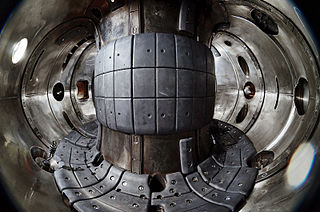
COMPASS, short for Compact Assembly, is a compact tokamak fusion energy device originally completed at the Culham Science Centre in 1989, upgraded in 1992, and operated until 2002. It was designed as a flexible research facility dedicated mostly to plasma physics studies in circular and D-shaped plasmas.
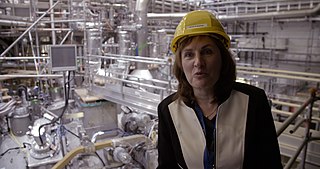
Sibylle Günter is a German theoretical physicist researching tokamak plasmas. Since February 2011, she has headed the Max Planck Institute for Plasma Physics. In October 2015, she was elected a member of the Academia Europaea in recognition of her contribution to research.
High-confinement mode, or H-mode, is an operating regime possible in toroidal magnetic confinement fusion devices – mostly tokamaks, but also in stellarators. In this regime the plasma has a higher energy confinement time.

A sawtooth is a relaxation that is commonly observed in the core of tokamak plasmas, first reported in 1974. The relaxations occur quasi-periodically and cause a sudden drop in the temperature and density in the center of the plasma. A soft-xray pinhole camera pointed toward the plasma core during sawtooth activity will produce a sawtooth-like signal. Sawteeth effectively limit the amplitude of the central current density. The Kadomtsev model of sawteeth is a classic example of magnetic reconnection. Other repeated relaxation oscillations occurring in tokamaks include the edge localized mode (ELM) which effectively limits the pressure gradient at the plasma edge and the fishbone instability which effectively limits the density and pressure of fast particles.
Hartmut Zohm is a German plasma physicist who is known for his work on the ASDEX Upgrade machine. He received the 2014 John Dawson Award and the 2016 Hannes Alfvén Prize for successfully demonstrating that neoclassical tearing modes in tokamaks can be stabilized by electron cyclotron resonance heating, which is an important design consideration for pushing the performance limit of the ITER.
Keith Howard Burrell is an American plasma physicist.
Kunioki Mima is a Japanese plasma physicist. He is known for his contributions to the theory of turbulent transport in plasmas, and in particular the derivation of the Hasegawa–Mima equation in 1977, which won him the 2011 Hannes Alfvén Prize.
Patrick Henry Diamond is an American theoretical plasma physicist. He is currently a professor at the University of California, San Diego, and a director of the Fusion Theory Institute at the National Fusion Research Institute in Daejeon, South Korea, where the KSTAR Tokamak is operated.
Patrick Mora is a French theoretical plasma physicist who specializes in laser-plasma interactions. He was awarded the 2014 Hannes Alfvén Prize and 2019 Edward Teller Award for his contributions to the field of laser-plasma physics.
Sergei Vladimirovich Bulanov, is a Russian physicist. He received the 1983 State Prize of the USSR, the 2016 Hannes Alfvén Prize for "contributions to the development of large-scale next-step devices in high-temperature plasma physics research", and the Order of Rising Sun with Gold Rays and Rosette in 2020.
Jürgen Nührenberg is a German plasma physicist.
Thomas W. L. "Tom" Sanford is an American plasma physicist who developed a multi-wire array for use in a pulsed Z-pinch plasma system which resulted in a breakthrough for inertial confinement fusion (ICF) research. In 2005, he was awarded the Hannes Alfvén Prize with Malcolm Haines and Valentin Smirnov for his contributions to the field.
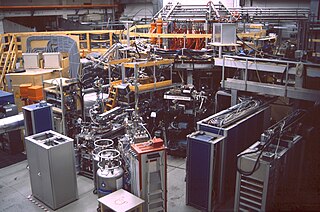
Wendelstein 7-AS was an experimental stellarator which was in operation from 1988 to 2002 by the Max Planck Institute for Plasma Physics (IPP) in Garching. It was the first of a new class of advanced stellarators with modular coils, designed with the goal of developing a nuclear fusion reactor to generate electricity.
John 'Jack' Connor is a British theoretical physicist whose research focussed on understanding the physics of nuclear fusion.
References
- ↑ Wagner, F.; Becker, G.; Behringer, K.; Campbell, D.; Eberhagen, A.; Engelhardt, W.; Fussmann, G.; Gehre, O.; Gernhardt, J.; Gierke, G. v.; Haas, G. (1982). "Regime of Improved Confinement and High Beta in Neutral-Beam-Heated Divertor Discharges of the ASDEX Tokamak". Physical Review Letters. 49 (19): 1408–1412. Bibcode:1982PhRvL..49.1408W. doi:10.1103/PhysRevLett.49.1408. ISSN 0031-9007.
- ↑ "How Fritz Wagner 'discovered' the H-Mode". ITER. Archived from the original on 2020-04-19. Retrieved 2020-06-13.
- ↑ "Prof. Dr. Friedrich Wagner". www.ipp.mpg.de. Retrieved 2020-06-13.
- ↑ "APS Fellow Archive". American Physical Society. Retrieved 2020-06-13.
- ↑ "1987 John Dawson Award for Excellence in Plasma Physics Research Recipient". American Physical Society. Retrieved 2020-06-13.
- ↑ "Alfvén Prize | European Physical Society – Plasma Physics Division". European Physical Society. Retrieved 2020-06-13.
- ↑ "Die Physik-Preisträger 2009". DPG. Retrieved 2020-06-13.
- ↑ Smith, Z E.; Wagner, S. (1987). "Band Tails, Entropy, and Equilibrium Defects in Hydrogenated Amorphous Silicon". Physical Review Letters. 59 (15): 688–691. doi: 10.1103/physrevlett.59.1790.3 . ISSN 0031-9007. PMID 10035845.